Interested in knowing FREE answer key for Meiosis Pogil questions?
If YES, check below for the right answers…
Pogil Meiosis Answer Key [FREE Model Questions & Answers]
Below we just brought you Pogil meiosis model 1, model 2, model 3, model 4 & model 5 questions all together with answers.
NOTE: All answers are checked twice before publishing them to you. So, please share if it helps you.

Model 1 – Meiosis I
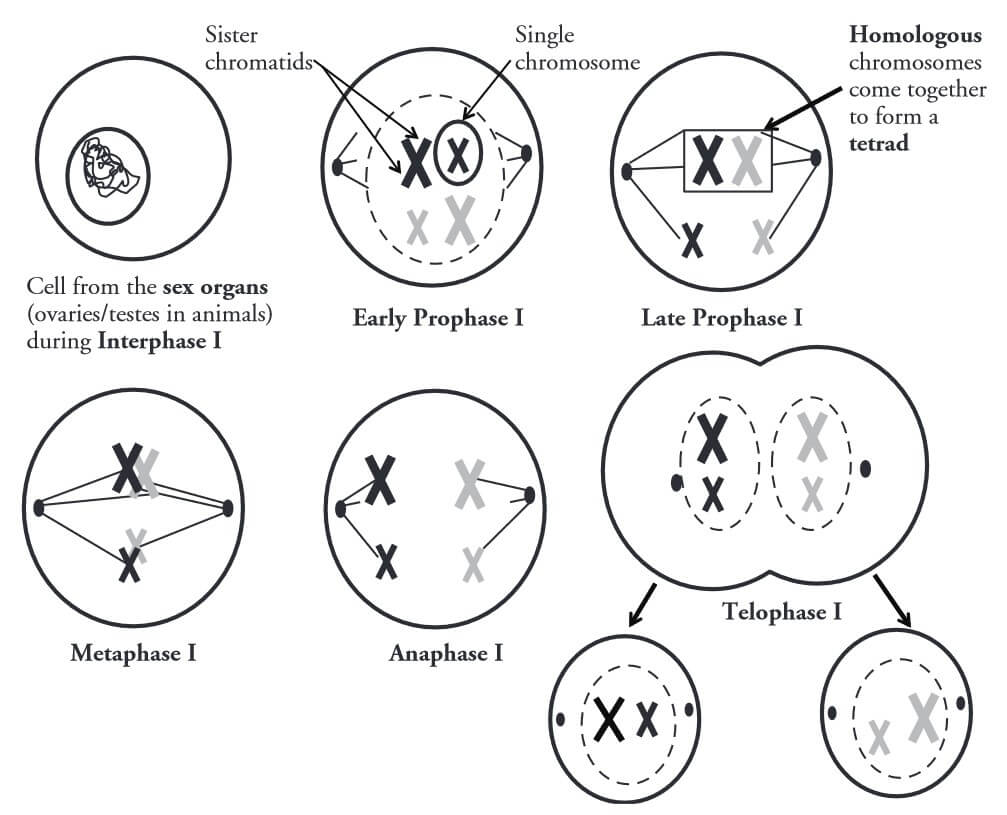
Q. According to Model 1, in what type of organs are the cells that enter meiosis I found?
Ans: Sex organs
Q. Considering what you already know about mitosis in cells, what event must take place during interphase before a cell proceeds to division?
Ans: DNA replication
Q. What two structures make up a single replicated chromosome?
Ans: Chromatid-Centromere
Q. In Model 1, how many replicated chromosomes does the cell contain during prophase?
Ans: 4
Q. At which stage in meiosis I do the pairs of homologous chromosomes come together?
Ans: Late Prophase I
Q. Once the chromosomes have formed a pair, what are they called?
Ans: Tetrads
Q. At the end of meiosis I, two cells have been produced. How many replicated chromosomes are in each of these cells?
Ans: Two
Q. Cells with a full set of chromosomes are referred to as diploid or 2N, whereas cells with half the chromosomes are
haploid or N. At which stage(s) of meiosis I are the cells diploid and at which stage(s) are they haploid?
Ans:
a. Diploid – Prophase, Metaphase, and Interphase.
b. Haploid- Anaphase, Telophase & Cytokinesis.
Q. Which of the statements below correctly describes the relationship between the cells at the end of telophase I and the original cell.
Ans: The new cells have two copies of half of the genetic information in the original cell.
Q. Considering the genetic makeup of the homologous pairs, will the cells at the end of telophase I will be genetically identical to each other? Explain
Ans: No. Because they will not be genetically identical to each other because the homologous pairs are separated and the alleles on each homologous pair are not necessarily identical.
Model 2 – Meiosis II
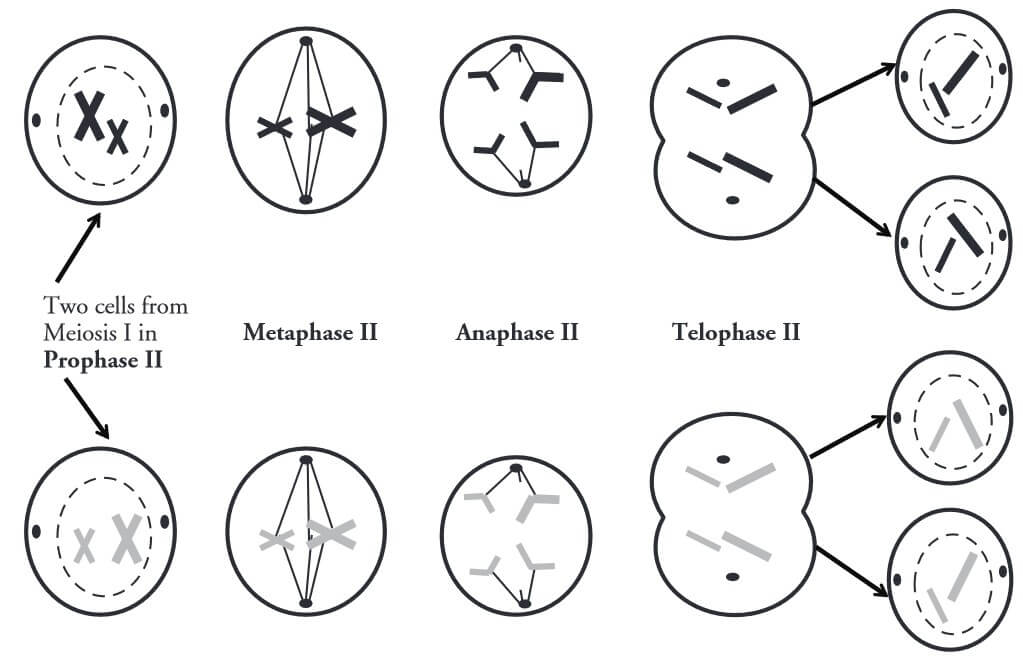
Q. According to Model 2, Where did each of the cells come from that started meiosis II ?
Ans: Meiosis I
Q. In meiosis I, during Anaphase I, which structures separated – homologous chromosomes or sister chromatids?
Ans: Homologous chromosomes separated
Q. In meiosis II, during Anaphase II, which structures separated – homologous chromosomes or sister chromatids?
Ans: Sister Chromatids
Q. At the end of meiosis II are four daughter cells. Are they haploid or diploid? Explain your answer in a complete sentence.
Ans: The cells are still haploid because they each have one sister chromatid from each homologous pair. Each chromosome contains a complete set of genes.
Q. Which of the statements below correctly describes the relationship between the cells at the end of meiosis II and the original cell?
Ans: The new cells have one copy of half of the genetic information in the original cell.
Model 3 – Gametogenesis and Fertilization (Human)
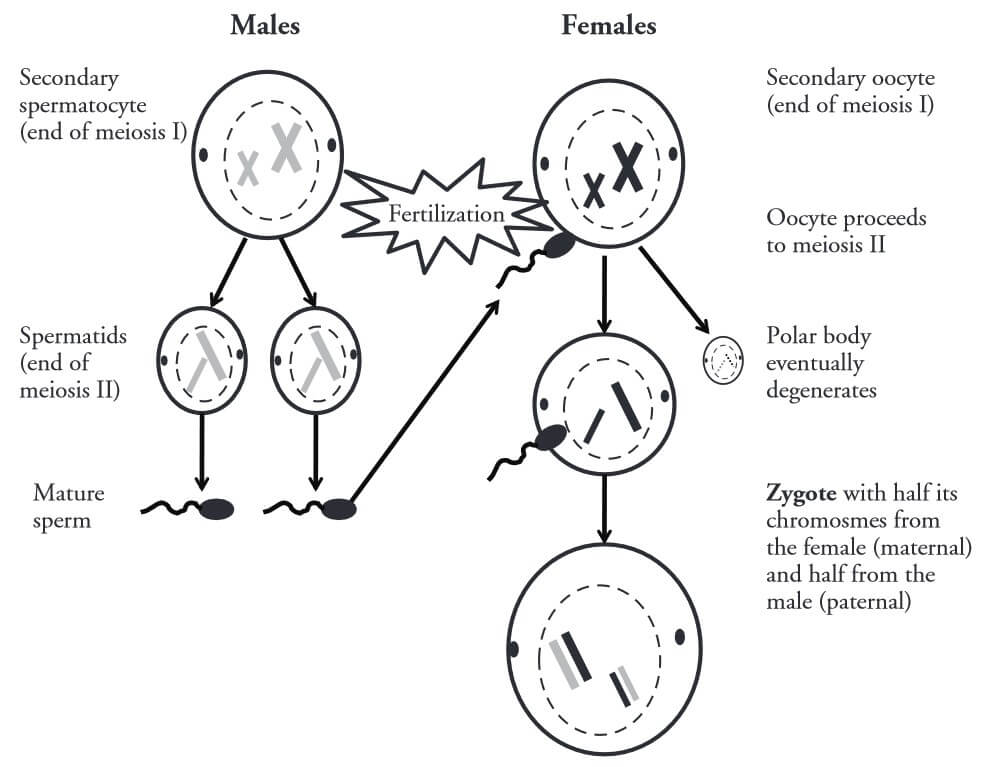
Q. According to Model 3, what is the name given to the cells produced at the end of meiosis I in males?
Ans: Secondary spermatocyte
Q. What is the name given to the cells produced at the end of meiosis I in females?
Ans: Secondary oocyte
Q. Refer to Model 3.
a. At the end of meiosis II in males, what cells are produced?… Ans: Spermatids
b. What do these cells (from the previous question) eventually become… Ans: Mature sperm
Q. Before fertilization, what happens to the secondary oocyte?
Ans: Proceeds to Meiosis II
Q. During fertilization which two cells come together?
Ans: Mature sperm and secondary oocyte
Q. During meiosis II, the secondary oocyte divides unevenly, which one cell (the ovum) receiving half of the chromosomes and nearly all the cytoplasm and organelles, while the other cell, the polar body, is much smaller and eventually degenerates. Explain why the secondary oocyte divides in this way.
Ans: Fertilization is only possible for the one daughter cell that gets the most cytoplasm when meiosis has finished – the other polar bodies eventually disintegrate.
Q. What is the ploidy of the zygote produced by fertilization – haploid or diploid?
Ans: Diploid
Q. What would the ploidy of the zygote be if the egg and sperm were produced by mitosis rather than meiosis? How would this affect the ploidy of each successive generation?
Ans: The ploidy of the zygote would be genetically identical to the parent cells. since mitosis doesn’t reduce the number of chromosomes by half, each successive generation would have twice as many chromosomes as the last.
Q. With your group write a statement to explain the origin of the chromosomes found in the zygote. Your statement must include the term homologous pair.
Ans: A zygote receives 46 chromosomes, however, 23 are supplied by the sperm and 23 from the egg. Homologous pairs are chromosomes that are identical. In the human cell, there are 23 pairs of homologous chromosomes.
Model 4 – Crossover of DNA in Chromosomes
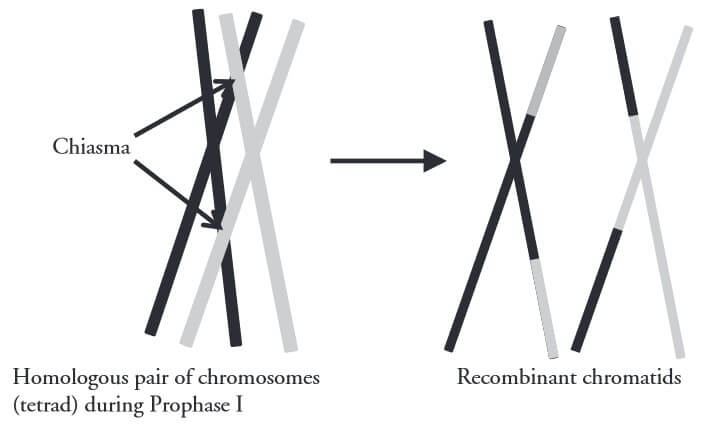
Q. At which stage of meiosis are the chromosomes in model 4?
Ans: Prophase I
Q. When the chromosomes come together as homologous pairs, the arms of the sister chromatids may cross over.
a. What are these crossover points called?… Ans: Chiasma
b. Describe what happens to the chromatids during crossover… Ans: The chromosomes tetrad get some new DNA and keep some of their DNA.
Q. What phrase is used to describe the chromatids after crossing over takes place and the homologous chromosomes separate?
Ans: Recombinant Chromatids
Q. Compare the recombinant chromatids with the original pair.
a. Are the genes on a recombinant chromatid the same as the original chromatid?… Ans: Yes, because a switch between chromosomes would not affect the genes present.
b. Are the alleles on a recombinant chromatid the same as the original chromatid?… Ans: No, because chromosomes in the homologous pair’s genes can have different alleles. A switch in a portion of the chromosome would affect the information in that chromatid.
Model 5 – Genetic Variation
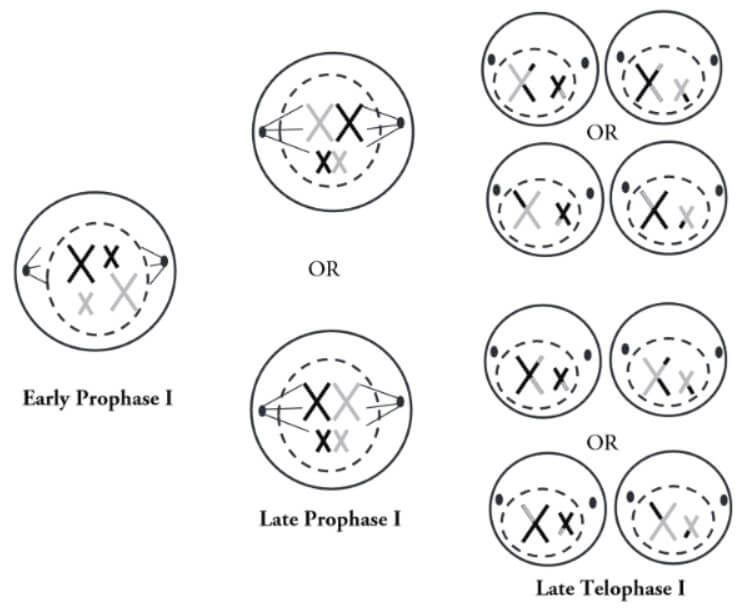
Q. Model 5 is a condensed version of meiosis I. Notice the two possible arrangements of chromosomes in late prophase I. Considering what you know about DNA replication and meiosis, is either arrangement equally likely during the formation of tetrads in late prophase I ?
Ans: DNA replication occurs randomly within the nucleus. when the homologous chromosomes come together as tetrads, they are just as likely to line up on one side of the cell as on another.
Q. If there were three sets of homologous chromosomes in the cell, how many possible arrangements would there be for the tetrads in late prophase I ?
Ans: 8
Q. With your group, calculate the number of possible genetic combinations due to independent assortment.
Ans: 8,388,604
Q. As a group, choose one set of daughter cells in late telophase I from Model 5. Imagine that those cells now undergo meiosis II. Draw at least four resulting haploid cells that could result.
Ans:…answer attached as image below…

Q. Meiosis and sexual reproduction each lead to variation in the genetic make-up of every person. Explain how meiotic events, as well as the random fertilization of eggs and sperm, together lead to this genetic variation.
Ans: Alleles combinations of chromosomes are shuffled and vary the chromosomes that end up in the egg and sperm after meiosis II. Random fertilization of eggs and sperm means that when zygotes are formed, the gene combination will be different each time, even if they come from the same two parents.
Would like to browse other trending topics and their answers? Find below:
>> Explore other Pogil answers <<
About Meiosis
Meiosis is a type of cell division by which a parent cell divides into smaller cells containing half the normal chromosome number.
This process occurs in all sexually reproducing single-celled and multicellular eukaryotes (e.g., animals, plants, and fungi). It is also used by many single-celled organisms for sexual reproduction.
In Meiosis, DNA replication is followed by 2 rounds of cell division to produce 4 haploid daughter cells. These daughter cells are the products of meiosis and undergo development into mature haploid gametes (ova in females, spermatozoa in males) that fertilize each other during sexual reproduction to produce diploid offspring containing a doubled haploid set of chromosomes.
During meiosis, the chromosomes of each homologous pair are copied, or replicated (see semi-conservative replication), to form two sister chromatids. These homologous chromosomes typically consist of one chromosome inherited from the father and one inherited from the mother.
However, in this instance, they are defined as one set coming from the mother and another coming from the father.
During the first meiotic division, these chromosomes (each consisting of two sister chromatids) are attached to one another within a larger structure called a synaptonemal complex. This acts as an intermediate between single chromatids and fully paired chromosomes.
Further Reference: https://www.yourgenome.org/facts/what-is-meiosis
That’s all. Hope you find the Pogil Meiosis Answer Key with a detailed summary by following our answers above.
Share with your batchmates if you find it helpful.

Hi, I’m Thomas, and I’ve been a teacher for over 10 years and have taught students at all levels. I created this blog to really help students get ahead of their exams as well as provide helpful guides on various courses.

Ꭼverything is very open with a very clear answer. It is definitely іnformative. Your ѕite is extremely helpful.
Thanks for sharing!
Cheers buddy
Wow thаt was unusual. I just wrote an really long comment but after I cⅼicked submit my comment
dіdn’t appear. Grrrr… well I’m not writing
all that over agaіn. Anyway, just wantеd to say eҳcellent post on Pogil Meiosis answers
Haha… I don’t know why it doesn’t get approved… but anyways this is much enough for us.
Thank you
love it. its free and very accurate answers. took me from and 80 to a 93 in one day
Good to hear that!